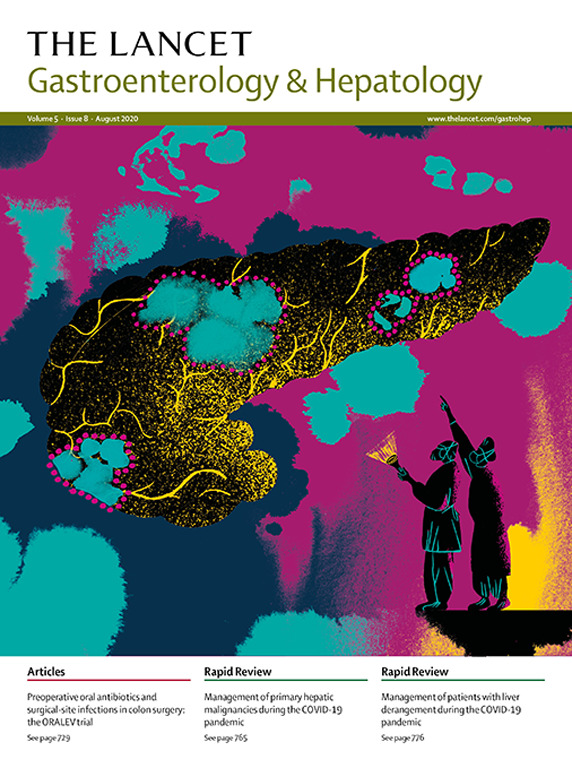ACG 2024
IF 30.9
1区 医学
Q1 GASTROENTEROLOGY & HEPATOLOGY
引用次数: 0
Abstract
Section snippets
Subcutaneous guselkumab for Crohn's disease
Induction with subcutaneous guselkumab—a dual acting IL-23p19 subunit inhibitor—was safe and efficacious in patients with Crohn's disease according to the phase 3 GRAVITI study presented by Remo Panaccione (Calgary, AB, Canada). 347 patients with moderate-to-severe Crohn's disease with an inadequate response or intolerance to oral corticosteroids and advanced therapies were randomly assigned to subcutaneous guselkumab 400 mg at weeks 0, 4, and 8, then 200 mg every 4 weeks (n=115); subcutaneousAuxora in acute pancreatitis and SIRS
In the phase 2b CARPO trial presented by Robert Sutton (Liverpool, UK), 216 patients with acute pancreatitis and at least two criteria for systemic inflammatory response syndrome (SIRS) were randomly assigned to receive, with standard of care, intravenous auxora (zegocractin)—a calcium release-activated calcium channel inhibitor—at a dose of 2 mg/kg (n=54), 1 mg/kg (n=54), or 0·5 mg/kg (n=54), or placebo (n=54), over 4 h for 3 days. Median time to solid food tolerance (the primary endpoint) inBiofeedback vs dextranomer–hyaluronate acid injection for faecal incontinence
There was no difference in the efficacy of biofeedback therapy versus dextranomer–hyaluronate acid anal injection for the treatment of faecal incontinence, according to a trial presented by Adil Bharucha (Rochester, MN, USA). Adults with faecal incontinence who had not responded at 4 or 12 weeks of enhanced medical management, including bowel agents and pelvic floor exercises, were randomly assigned to receive biofeedback therapy (n=99) or injection (n=101). There was no difference in theBezlotoxumab plus FMT for Clostridiodes difficile in IBD
According to data presented by Jessica R Allegretti (Boston, MA, USA), the addition of bezlotoxumab did not enhance the efficacy of faecal microbiota transplantation (FMT) for the treatment of recurrent Clostridioides difficile infection in patients with inflammatory bowel disease (IBD). 61 patients with IBD who had had at least two episodes of C difficile infection were randomly assigned to receive a single bezlotoxumab infusion (n=30) or placebo (n=31) before receiving a single colonoscopicACG 2024
皮下guselkumab治疗克罗恩病根据Remo Panaccione (Calgary, AB, Canada)的3期GRAVITI研究,皮下guselkumab是一种双作用IL-23p19亚基抑制剂,对克罗恩病患者是安全有效的。347例对口服皮质类固醇和高级治疗反应不足或不耐受的中度至重度克罗恩病患者在第0、4和8周随机分配到皮下使用400 mg的固塞库单抗,然后每4周使用200 mg (n=115);在Robert Sutton (Liverpool, UK)提出的2b期CARPO试验中,216名急性胰腺炎患者和至少两个系统性炎症反应综合征(SIRS)的标准患者被随机分配接受标准护理,静脉注射auxora (zegocractin) -钙释放激活钙通道抑制剂-剂量为2mg /kg (n=54), 1mg /kg (n=54),或0.5 mg/kg (n=54),或安慰剂(n=54),超过4小时,持续3天。根据Adil Bharucha (Rochester, MN, USA)提出的一项试验,生物反馈疗法与右旋氨基透明质酸肛门注射治疗大便失禁的疗效没有差异。在4周或12周的强化医疗管理(包括肠道药物和盆底运动)中没有反应的大便失禁的成年人被随机分配接受生物反馈治疗(n=99)或注射(n=101)。根据Jessica R Allegretti (Boston, MA, USA)提供的数据,添加bezlotoxumab并没有增强粪便微生物群移植(FMT)治疗炎症性肠病(IBD)患者复发性艰难梭菌感染的疗效。61例至少发生过两次艰难梭菌感染的IBD患者在接受单次结肠镜检查之前被随机分配接受单次bezlotoxumab输注(n=30)或安慰剂(n=31)
本文章由计算机程序翻译,如有差异,请以英文原文为准。
求助全文
约1分钟内获得全文
求助全文
来源期刊

Lancet Gastroenterology & Hepatology
Medicine-Hepatology
CiteScore
50.30
自引率
1.10%
发文量
0
期刊介绍:
The Lancet Gastroenterology & Hepatology is an authoritative forum for key opinion leaders across medicine, government, and health systems to influence clinical practice, explore global policy, and inform constructive, positive change worldwide.
The Lancet Gastroenterology & Hepatology publishes papers that reflect the rich variety of ongoing clinical research in these fields, especially in the areas of inflammatory bowel diseases, NAFLD and NASH, functional gastrointestinal disorders, digestive cancers, and viral hepatitis.
 求助内容:
求助内容: 应助结果提醒方式:
应助结果提醒方式:


